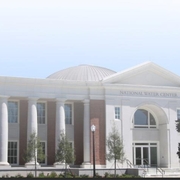19 – 21 July 2016 Tuscaloosa, AL
Thank you for attending the 2016 Summer Community Meeting!
National Water Center Fact Sheet
WATER IS LIFE: SOCIETAL CHALLENGES & ENTERPRISE OPPORTUNITIES
Both society and the AMS community have come to recognize the importance of water…
…at various times and places as a stressed natural resource;
…at times as a threat to life, property, and livelihoods;
…but always as an essential component of sustainable and resilient communities.
Examples of recent water headlines include:
- Extreme precipitation events across the country causing life threatening flash flooding;
- Historical severe drought conditions in California and the Southwest;
- Coastal flooding from extreme events like hurricanes and more regular, so-called “nuisance flooding” of coastal towns and cities;
- Public health issues (e.g., harmful algal blooms) associated with water supplies in the Great Lakes and elsewhere; and
- International water scarcity/food shortage impacts to U.S. national security.
Demands for relevant, science based information continues to grow and it is clear to meet these information demands, the public, private, academic and NGO sectors will need to work closely together and with affected economic sectors as well as local, national and international government agencies.
During this meeting we explored the challenges and opportunities through individual presentations, panels and group discussion. Topics included:
- What are the motivating societal questions driving a need for better information to support decisions on both weather and climate time scales?
- What are the key challenges for the public, private and academic partners in the weather-water-climate Enterprise in addressing those questions?
- What is the current state of hydrologic sensing, models and inundation mapping and what future plans exist to advance the understanding of the science behind improving precipitation forecasts (e.g., forecasting convection at various scales)?
- How well is water represented in climate model outlooks and how can improvements be made?
- How can we improve our ability to communicate scientific and technical information in ways that support public/private decision-making?
- What opportunities for innovative partnerships exist?
Based on these discussions and community feedback, we identified near-term opportunities and long-term strategies to pursue as a Society and beyond the weather, water, and climate enterprise.
